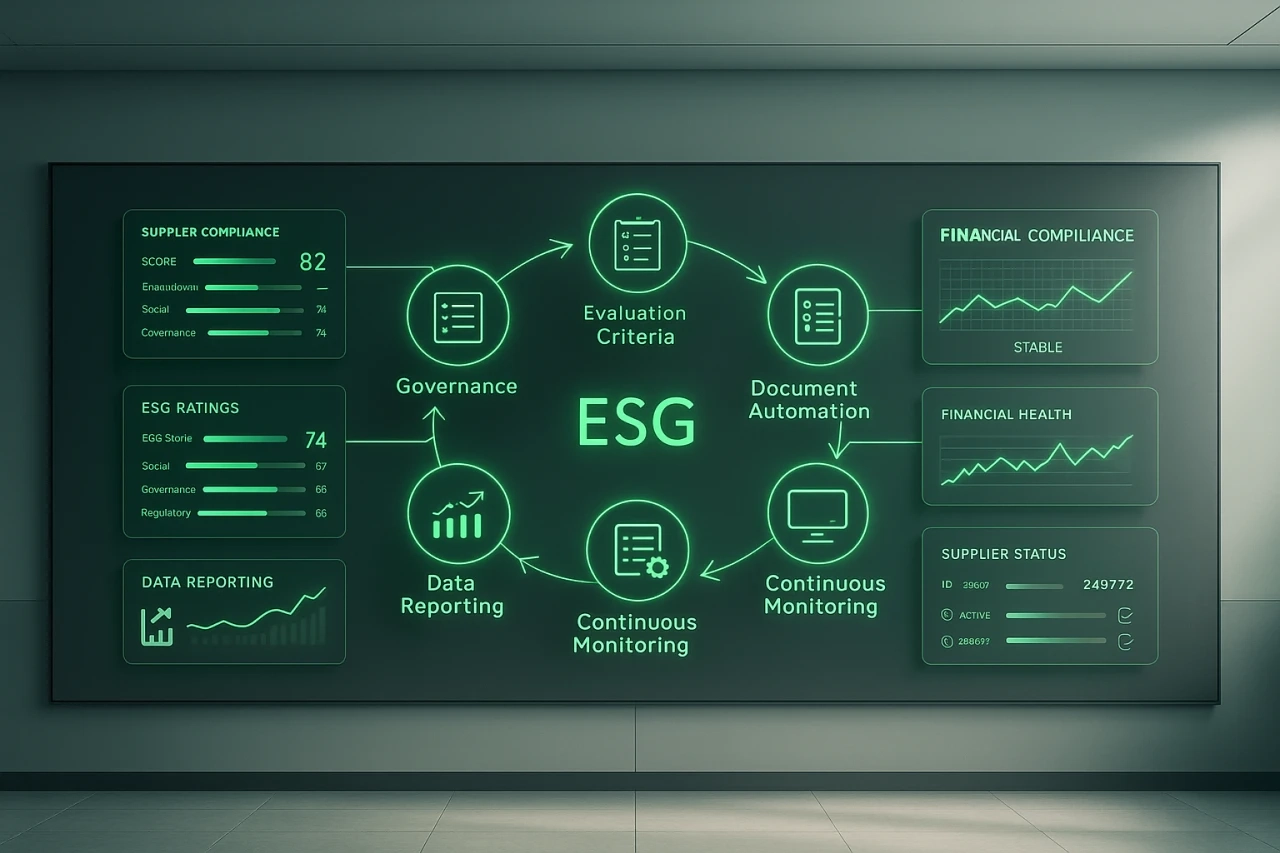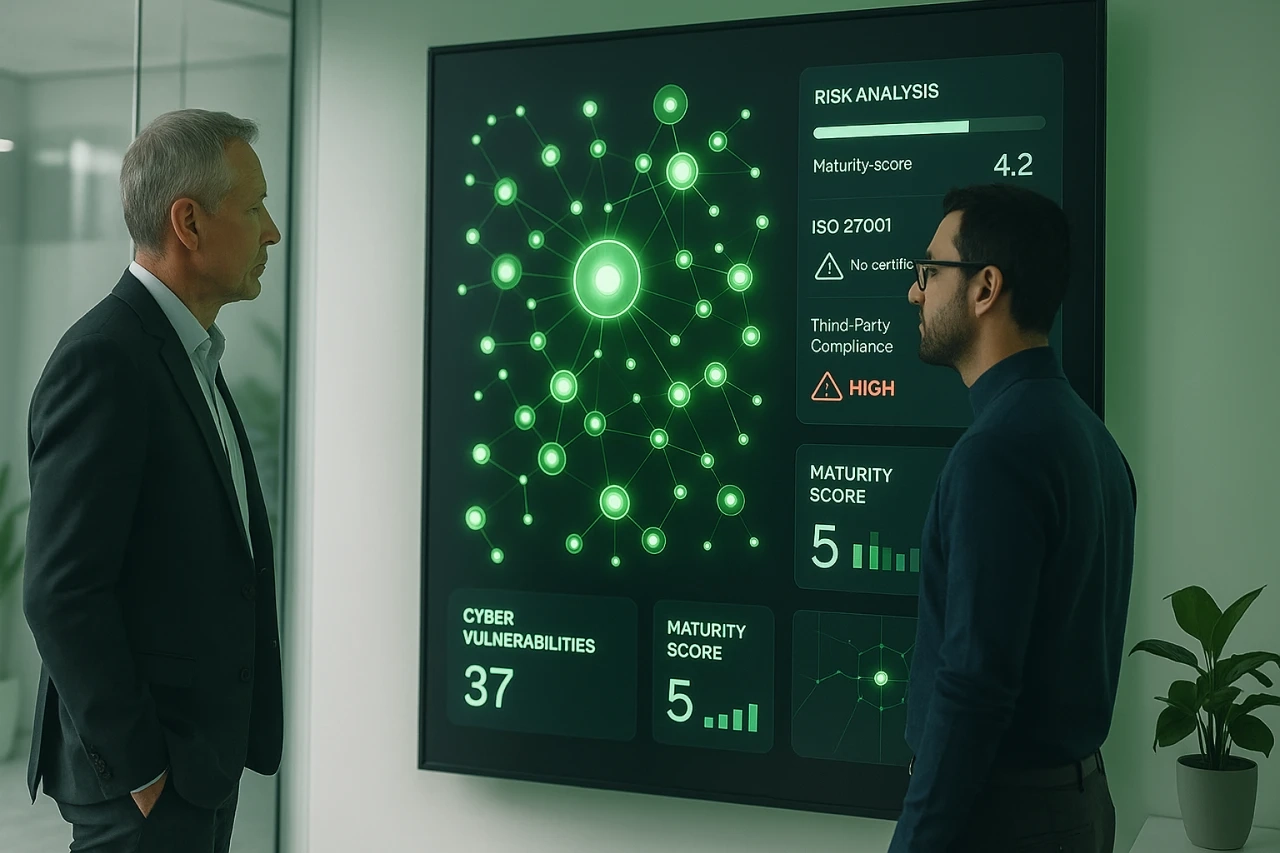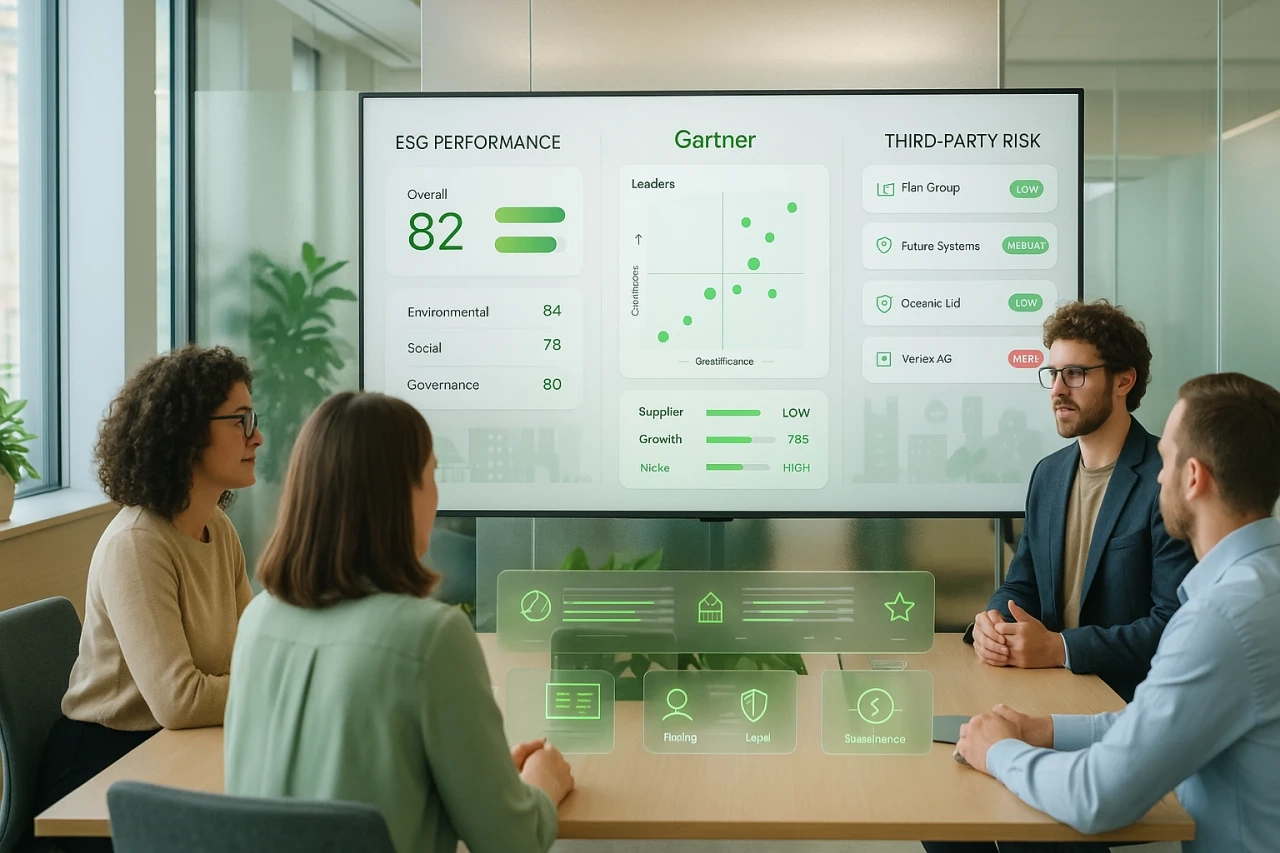The 6 Pillars of an Effective Supplier Evaluation Solution

According to a 2025 Accenture study, 63% of companies are undergoing transformation. As a result, CIOs, procurement managers, and compliance officers are rethinking their approach to third-party governance. In both public and industrial sectors, it is no longer just about collecting administrative documents, but about structuring supplier relationship management to sustainably strengthen operational resilience.
Adopting a collaborative evaluation solution based on six complementary pillars not only meets regulatory requirements but also delivers measurable ROI at every step. This method supports the construction of a tailored decision matrix per sector while minimizing supplier fatigue, often seen with traditional audit methods.
Pillar 1: Automated Governance of Third-Party Relationships
Third-party governance relies on a clear policy reinforced by intelligent automation. In the public sector, this formalization structures the management of third-party partners during public tenders or contract awarding. Social housing organizations use this approach to secure maintenance and construction contractor relationships, ensuring compliance with anti-corruption obligations.
In industry, automation simplifies the identification of critical subcontractors on ICPE sites, ensuring supplier performance across the value chain. Manufacturing groups can map REACH-related risks and maintain proactive regulatory compliance.
Intelligent automation ensures data reliability while significantly reducing the administrative burden for Procurement teams. A robust solution offers customizable automated workflows aligned with business risks, systematic traceability of every action, and seamless integration with existing CSR policies. This collaborative approach transforms third-party governance while enhancing social responsibility.
Pillar 2: A Unified Framework of Evaluation Criteria
Effective supplier evaluation relies on a solid multi-criteria framework. Whether it’s operational performance, compliance, or environmental responsibility, each criterion must be adapted to sector-specific criticality and ranked for informed decision-making.
For social housing or local authorities, regulatory obligations (anti-corruption, SPASER, duty of vigilance) are a core foundation. The progressive integration of ESG indicators and social clauses is a powerful lever to promote committed third-party partners. Public entities that have adopted a holistic approach to third-party governance report significant improvements in contractual relationship quality.
In the private sector, product/service quality and process sustainability are central to evaluation. Weighting each criterion—certifications, ICPE approvals, performance indicators, or business continuity plans—naturally guides selection toward the most reliable partners. Industrial companies integrating ESG into supplier evaluation observe improved overall performance and reduced hidden costs from non-compliance.
Want to structure your evaluation criteria by industry?
Check out our practical guide on integrating ESG criteria and receive a personalized assessment of your current evaluation grid.
Pillar 3: Automated Collection and Verification of Evidence
A supplier evaluation’s efficiency heavily depends on the ability to gather and verify documents and evidence without increasing the administrative burden for teams and partners. An automated system—dynamic reminders, smart alerts, granular access for third-party partners—optimizes internal and external responsiveness.
In the public sector, automating document collection transforms public procurement management. Anti-corruption automation helps housing bodies maintain compliance and reduce supplier dossier processing times. Integrating information systems into TPRM platforms enables automatic data sync with public databases.
In industry, automation is crucial for managing complex certifications. ICPE sites can now automate REACH qualification checks for subcontractors, ensuring enhanced business continuity. This approach helps manufacturers remain compliant while optimizing collaborative evaluation processes.
Automation also directly contributes to procurement optimization and reduces supplier panel solicitation, lowering administrative overload. Secure data mutualization lets organizations intelligently share previously collected information, avoiding document redundancies. This method, validated by 450,000+ third parties worldwide, transforms the third-party partner experience by eliminating repetitive document submissions.
Pillar 4: Continuous Monitoring and Intelligent Alerting
A powerful solution doesn’t stop at one-time assessments: continuous monitoring and smart alerts are essential for anticipating deviations and controlling risks. In the public sector, these features ensure compliance and reduce reputational or financial risks.
Continuous monitoring uses AI to revolutionize external partner evaluation. It detects document anomalies and weak signals indicating deteriorating partner situations. Document AI continuously scans information streams to proactively alert teams to emerging risks.
Ready to automate your third-party risk monitoring?
Learn how AI revolutionizes third-party evaluation and request a demo of our predictive analysis capabilities.
In industry, proactive tracking of performance indicators and early anomaly detection enables agile supplier chain management. Manufacturers using this strategy benefit from better anticipation of service disruptions, a clear sign of monitoring’s contribution to operational resilience.
Smart alerts go beyond notifications: they contextualize alerts based on business needs. In construction, this feature prioritizes alerts related to site certifications or HSE approvals, ensuring optimal reactivity for safety-critical issues.
This continuous monitoring approach aligns with the TPRM to TPGRC transition, offering a collaborative and holistic vision of third-party governance.
Pillar 5: Transparent Reporting and Data-Driven Decision-Making
Decision-making depends on access to consolidated, usable information. Powerful reporting tools with visual dashboards and instant exports allow IT, Procurement, and Compliance departments to quickly respond to third-party governancechallenges.
In the public sector, transparent reporting improves internal and external communication: proof of multi-regulation compliance, sharing standardized profiles with auditors, and proactive ESG practice promotion. Social housing organizations using dynamic, customizable TPGRC dashboards ensure compliance monitoring of third-party partners and shorten audit response times.
Industry especially benefits from real-time visualization of critical performance indicators. ICPE sites can now monitor subcontractor REACH compliance through specialized sector dashboards, ensuring operational robustness.
The third-party risk dashboard enhances management and monitoring by consolidating critical data into a unified interface. This approach helps teams turn raw data into actionable insights for better strategic decisions.
Pillar 6: Open and Scalable Integration into the IT Ecosystem
Interoperability with IT systems ensures agility and scalability. Integrating the solution with an ERP, SRM, or sector-specific platform avoids disruptions or sensitive data loss.
Integrating information systems into TPRM platforms is a key strategic issue for modern organizations. Native integration automatically syncs data across business systems, maintaining up-to-date and coherent third-party partner information.
In the public sector, this technological openness breaks silos between departments (procurement, legal, compliance) and boosts overall efficiency. Local governments using this integrated method maintain regulatory compliance while streamlining internal processes.
In industry, integration with ERP and quality management platforms enables unified supply chain management. This supports multi-entity TPRM deployment for large groups, ensuring consistent third-party governance policy application worldwide.
Modern platforms also offer the scalability to adapt to regulatory changes. Organizations with open architecture can quickly adopt new DORA, NIS 2, or CSRD requirements without disrupting existing processes.
Does your organization operate across multiple entities or subsidiaries?
Check out our multi-entity TPRM deployment strategy and get a free audit of your current setup to optimize global third-party governance.
Decision Matrix: How to Choose the Right Supplier Evaluation Solution
Selecting the right solution requires cross-analysis of sector needs and available features. Building a decision matrix helps clarify this and point to the TPRM platform with essential features suited to each organizational context.
Organizations should assign an objective score to each pillar based on business priorities: automation level at start-up, evaluation criteria adaptability, performance monitoring, reporting options, data visualization, system integration, and multisite compliance management.
In the public sector, weighting should focus on regulatory security and transparency with external stakeholders. Public bodies will favor solutions offering complete traceability and automatic generation of compliance reports required by oversight authorities.
Industry and construction sectors prioritize predictive service incident handling and operational traceability. These sectors need solutions that adapt to complex regulations while maintaining high operational agility.
Regardless of sector, alignment with these six pillars forms the foundation of effective collaborative evaluation—a long-term source of risk control and procurement optimization. This holistic third-party governance approach transforms third-party relationships into performance and compliance drivers.
These articles might interest you
-
 01 July 2025Cyber Risk Among Suppliers: A Strategic Priority for Procurement TeamsSecteurAs a single cyberattack can now paralyze an entire production line, identifying cyber vulnerabilities within your supplier network is no longer optional. It has become a strategic lever, at the intersection of business continuity, compliance, and operational resilience. Data That Speaks for Itself Between 2021 and 2023, business disruptions caused by cyberattacks targeting suppliers surged […]
01 July 2025Cyber Risk Among Suppliers: A Strategic Priority for Procurement TeamsSecteurAs a single cyberattack can now paralyze an entire production line, identifying cyber vulnerabilities within your supplier network is no longer optional. It has become a strategic lever, at the intersection of business continuity, compliance, and operational resilience. Data That Speaks for Itself Between 2021 and 2023, business disruptions caused by cyberattacks targeting suppliers surged […]Read more
-
 14 May 2025Environmental Criteria for Third-Party Partner EvaluationSecteurMore and more companies are incorporating environmental preservation into their overall strategy. Whether through sustainable practices or compliance with the CSRD (Corporate Sustainability Reporting Directive), these organizations aim to reduce their ecological footprint. The evaluation of suppliers plays a crucial role in this process, using various environmental criteria to ensure a responsible supply chain. What […]
14 May 2025Environmental Criteria for Third-Party Partner EvaluationSecteurMore and more companies are incorporating environmental preservation into their overall strategy. Whether through sustainable practices or compliance with the CSRD (Corporate Sustainability Reporting Directive), these organizations aim to reduce their ecological footprint. The evaluation of suppliers plays a crucial role in this process, using various environmental criteria to ensure a responsible supply chain. What […]Read more
-
 18 May 2025Multi-Entity TPRM Deployment for Large Groups: Strategy and ChallengesSecteurIn a context where large groups are orchestrating increasingly vast ecosystems of third parties, multi-entity deployment of TPRM has become a major strategic imperative. Société Générale exemplifies this reality with 119,000 employees across 62 countries, highlighting the operational complexity of modern multi-site structures. This exponential complexity calls for third-party governance adapted to the challenges of […]
18 May 2025Multi-Entity TPRM Deployment for Large Groups: Strategy and ChallengesSecteurIn a context where large groups are orchestrating increasingly vast ecosystems of third parties, multi-entity deployment of TPRM has become a major strategic imperative. Société Générale exemplifies this reality with 119,000 employees across 62 countries, highlighting the operational complexity of modern multi-site structures. This exponential complexity calls for third-party governance adapted to the challenges of […]Read more
-
 11 June 2025Decoding Gartner Evaluation Criteria for European Third-Party Governance PlatformsSecteurAs third-party governance becomes a cornerstone of operational resilience for organizations, Gartner’s Magic Quadrant evaluation standards stand out as an essential benchmark. However, their application within the European market demands a methodical adaptation to incorporate regulatory compliance with DORA, NIS 2, and CSRD, while ensuring data sovereignty and security. This dual imperative shapes how decision-makers in the […]
11 June 2025Decoding Gartner Evaluation Criteria for European Third-Party Governance PlatformsSecteurAs third-party governance becomes a cornerstone of operational resilience for organizations, Gartner’s Magic Quadrant evaluation standards stand out as an essential benchmark. However, their application within the European market demands a methodical adaptation to incorporate regulatory compliance with DORA, NIS 2, and CSRD, while ensuring data sovereignty and security. This dual imperative shapes how decision-makers in the […]Read more
